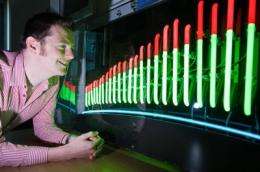Northern Lights in the classroom

A new model created by Lancaster University space scientist Dr Jim Wild is bringing the experience of the Northern Lights into the classroom.
The “Aurora in a box” which recreates the physics involved in the creation of the Northern Lights or Aurora Borealis, will be used to demonstrate how electrically charged particles in the atmosphere create the spectacle seen at the earth’s poles.
Dr Wild, a Physicist studying the space environment and the links between the Sun, the Earth and other planets, was awarded a grant from Research Councils UK to create theoutreach tool to explain the research to non-specialist audiences.
“The science of the aurora is basically the same as that of a neon lamp, like any found in shops and advertising displays”.
“I really like the idea that something really familiar, and something that seems so magical, are exactly the same physics”
Auroras are linked to the solar wind, a flow of ions and electrons continuously flowing outward from the Sun. The Earth's magnetic field traps these particles, most of which travel toward the poles where they are accelerated towards the Earth. Collisions between these particles, and atmospheric atoms and molecules, causes energy releases in the form of streams or arches of coloured light.
The “Aurora in a box” consists of glass tubes full of gas through which electrons move, causing the gas to fluoresce exactly as it does at the Earth’s poles.
Dr Wild uses the model to help him explain his research to children in schools, at university events and at national science events such as National Science and Engineering Week’s Big Bang event in Manchester last year.
Research into what causes auroras has many implications.
“For a start it’s just really interesting science, but it also has very practical uses,” says Dr Wild.
“We use a lot of technology in space, like communications and positioning satellites, and those satellites are sometimes outside the protection of the Earth’s magnetic field. They’re therefore more vulnerable to changes in space weather and can be damaged or have their services disrupted. Being able to predict this would be very useful.”
Provided by Lancaster University


















